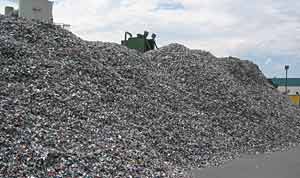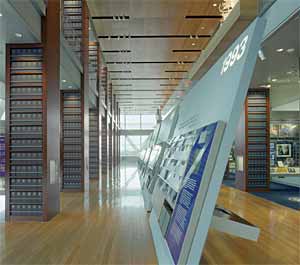Perforated Metal and Wood Ceilings: Sustainability, Acoustics, and Aesthetics
Sustainable Ceilings and LEED
Environmental characteristics can be critical to the design of a building seeking to comply with the U.S. Green Building Council's (www.usgbc.org) Leadership in Energy and Environmental Design (LEED) program. LEED provides a framework for achieving sustainability. The program is based upon a checklist of criteria that, if met, earn credits toward LEED certification of the project as a sustainable building.
Over a dozen LEED prerequisites and credits can be impacted by a building's ceilings.
Ceiling systems can contribute directly towards LEED credits. This analysis is based upon LEED for New Construction, Version 2.2.
Recycled Material Content (LEED Credit MR-4): Ceilings are now manufactured with a wide range of recycled materials, including metal, paper, glass, and slag. Of these, metal ceilings can have the greatest recycled content; some ceilings are now produced with up to up to 85 percent recycled aluminum, including as much as 75 percent post-consumer recycled content primarily from beverage containers. Steel used in ceiling suspension systems can have between 25 percent and 30 percent recycled material content.
|
There are ready markets for scrap aluminum, and the material can be recycled repeatedly without degradation of its metallurgical properties. Recycled aluminum requires only five percent of the energy needed to make aluminum from bauxite ore. Recycling is a relatively clean process that produces little pollution other that that associated with the energy used to melt and process the metal.
Perforated ceilings can be made with 85 to 98 percent recycled aluminum.
Local/Regional Materials (LEED Credit MR-5): Using materials produced near the location of a project supports the region's economy, stimulates regionally-responsive architecture, and reduces the energy consumed in transport. Ceilings can help a building qualify for this credit if raw materials are extracted or the place of final manufacturing is within 500 miles of the project. Aluminum ceilings can be especially attractive with regards to local extraction of materials. This is because aluminum made from locally collected beverage containers can be converted back to sheet material at small, often local, reclaimers.
|
Rapidly Renewable Materials (LEED Credit MR-6): Bamboo can grow to harvestable size in as little as three years, regenerates without replanting, and requires minimal fertilization or pesticides. As an ecologically-friendly material, bamboo enjoys growing acceptance as an architectural finish and an alternative to wood in products such as flooring. Recently, bamboo has been introduced as a finish for ceiling panels. Veneers of bamboo are laminated to recycled aluminum cores in the same way described above for wood panels.











